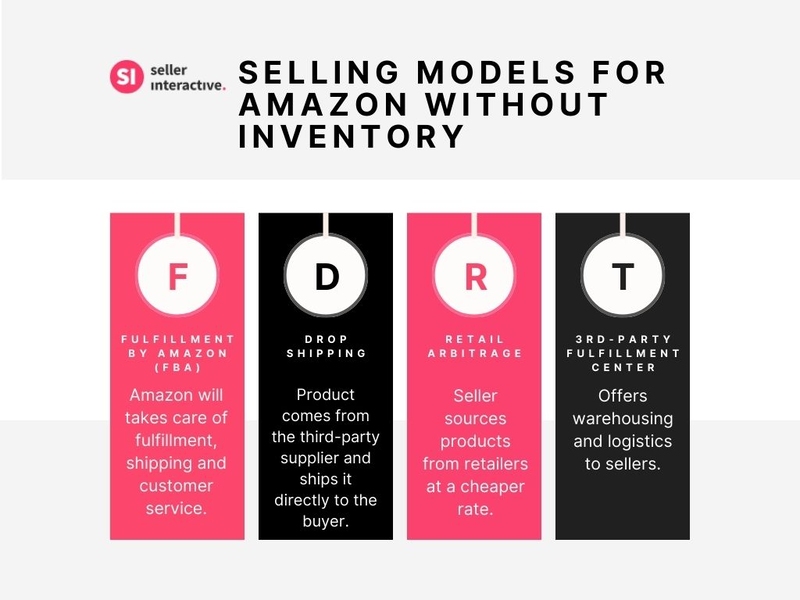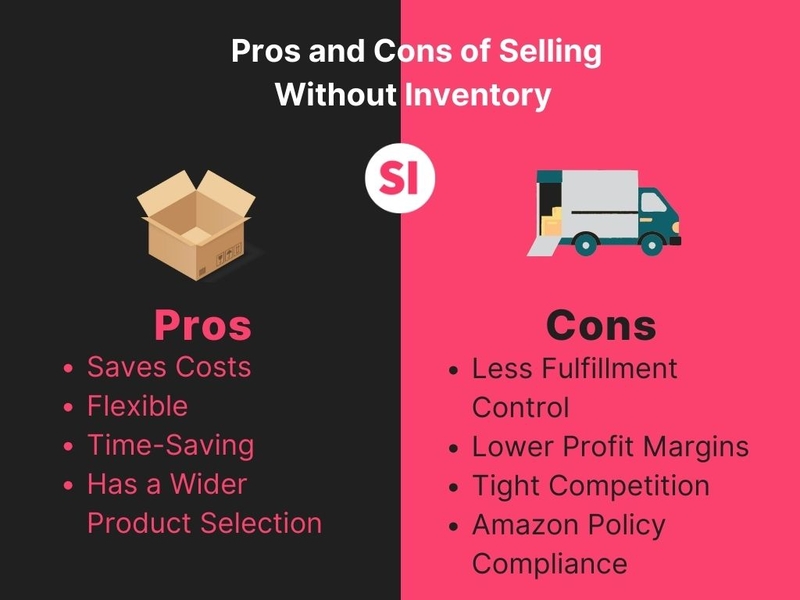Last updated on December 4th, 2023 Written by Mohamed Aden Are you looking to learn how to sell on Amazon without inventory so you can break into the lucrative world of ecommerce? This is a question a lot of...
Last updated on December 4th, 2023
 Written by Mohamed Aden
Written by Mohamed Aden
Are you looking to learn how to sell on Amazon without inventory so you can break into the lucrative world of ecommerce? This is a question a lot of aspiring entrepreneurs like you are asking.
Selling on Amazon is a quick way for individuals and businesses to reach a vast customer base. However, managing inventory is challenging, especially for small-scale sellers and those just starting.
Fortunately, there are methods available that allow you to sell on Amazon without maintaining an inventory apart from selling digital products. Let us introduce you to several methods without keeping a single item in your storage.
Selling Models for Amazon Without Inventory
Keeping inventory may get increasingly challenging as ecommerce sales ramp up, so a practical choice is to find ways to avoid holding inventory in the first place.
Note that the options recommended below don't involve the method to sell digital products, as this can be another topic worth discussing in a separate article. With that said, here are the methods you can use for your Amazon business.

Fulfillment by Amazon (FBA)
FBA is the most convenient option if you want to efficiently sell on Amazon without the need to manage inventory themselves. Through this service, you can store your products in Amazon's fulfillment centers and let Amazon handle all the logistics and shipping.
To start with FBA, you must first open a seller account. After this, you can send your products to Amazon's fulfillment centers. When an order arrives, Amazon will pick, pack, and ship the products directly to the buyer.
This service enables you to reach millions of Amazon Prime customers by offering fast and reliable Prime shipping and customer service options. You can also keep track of your ecommerce sales, manage your FBA inventory, and monitor the performance of your business through the FBA Seller Dashboard.
Dropshipping
Dropshipping is a method where you do not keep the products you sell in stock. Instead, if an order comes in, you will forward it to a third-party supplier, who then ships the product directly to the customer.
In this method, you may create a dropshipping website offering various non-digital products, such as clothing or accessories. As customers browse the site and make purchases, you donít need to store these items physically. Instead, the orders are passed along to a dropshipping service that handles the delivery of the products to the end customer.
By using a dropshipping model, you can benefit from lower startup costs and can focus on marketing and customer service. It is important to note that product quality and timely delivery are reliant on the chosen dropshipping supplier, so researching and selecting a reliable partner is crucial for success.
Retail Arbitrage
Retail arbitrage is when you buy discounted or marked-down items from retail stores and then sell them online. You can sell the products on Amazon at the prevailing market price. The difference between the purchase price and the selling price becomes the profit margin, allowing you to earn money without maintaining your inventory or warehouse storage.
Retail arbitrage can be time-consuming though, requiring constant scouting of retail stores for suitable products. It may also involve negotiating with the store's management for additional discounts or price reductions. It's crucial to consider product quality, shipping, and Amazon's fees when calculating potential returns on investment.
Third-Party Fulfillment Center
A third-party fulfillment center is another excellent solution if you want to sell on Amazon without physically managing your inventory. These logistics providers take care of warehousing, fulfillment, and shipment of products on your behalf. By using third-party inventory solutions, reducing overhead costs and eliminating the need for storage facilities. You can also pay attention to your businessí marketing and customer service.
Third-party logistics (3PL) providers purchase inventory from sellers and store it in their warehouses, alleviating the need for you to have your own. When an order is placed on Amazon, the 3PL provider fulfills the product and ships it directly to the customer.
Challenges and Solutions When Selling Without Inventory
Despite being practical and efficient, selling without keeping inventory has its challenges. Knowing these issues and how to manage them will help you put out fires in the logistics and inventory aspect of your business. As a result, you can pay attention to managing your Amazon account while ensuring profits flow.
Managing Suppliers
One challenge when running an online business without inventory is effectively managing suppliers. This becomes even more crucial when using Amazon's fulfillment centers for your products. As an Amazon seller, it's important to establish a steady supplier who can deliver the items you need promptly. Some of our recommended solutions are:
| Researching and vetting your suppliers thoroughlyBuilding strong relationships with your chosen suppliersUsing automated tools to monitor and manage orders |
By doing these, you can ensure a consistent product supply that matches customer demand and maintains smooth operations.
Maintaining Quality Control
Without inventory, quality control can be challenging as supply, fulfillment, and shipping are sourced to a 3rd party. To maintain quality control, consider the following solutions:
| Purchase a test order from the supplier periodically to check if the quality of the items is up to your standards.Do a site visit to your chosen supplier and implement inspection processes before you sell products to customers.Periodically evaluate supplier performance based on customer feedback.Address complaints and negative feedback from buyers as soon as possible. |
Finding the Right Price
Striking the right balance between having competitive pricing and maintaining profitability can be tricky, especially when selling without inventory. Here are some solutions to help find the optimal product price point:
| Research competitor pricing and market trends and use them as benchmarks for setting prices and discounts.Employ pricing tools that dynamically update your prices based on existing demand and competition.Analyze your costs, including supplier and Amazon fees, so you can set a sustainable profit margin. |
Managing Customer Demand
An essential aspect of any online business is generating buyer demand when itís low and meeting it when itís high, which can be particularly challenging when selling without inventory. To continue making sure demand meets supply as an Amazon seller, consider the following solutions:
| Analyze historical data and sales trends to anticipate and forecast future demand.Ensure sufficient quantities of products are shipped to Amazon fulfillment centers promptly.Continuously evaluate product popularity and set appropriate stock levels based on performance.Do search engine optimization and invest in good pay-per-click ads management to ensure you generate demand according to supply. |
Pros and Cons of Selling Without Inventory
Selling on Amazon without inventory is a strategy you can adopt to save on storage costs. It's an excellent way to earn money fast, but you still have to weigh its benefits and drawbacks. Let us present the pros and cons of selling without inventory here.

Pros:
Saves Costs: By not having inventory, you can eliminate storage expenses and decrease financial risks associated with unsold products. Flexiblee: With no need to manage physical inventory, you can quickly adapt your offers to meet changing market demands. Time-Saving: Since the supplier handles the logistics, you save time and can allot it in other revenue-generating business activities. Has a Wider Product Selection: Without inventory concerns, you can offer a larger range of products by collaborating with various suppliers.Cons:
Less Fulfillment Control: Relying on third-party suppliers can lead to errors or delayed shipping, negatively impacting your reputation. Tight Competition: The ease of selling without inventory can lead to increased competition, as barriers to entry are significantly reduced. Amazon Policy Compliance: You must navigate and adhere to Amazon's strict policies regarding dropshipping and partnering with suppliers or risk account suspension.Without Inventory, You Can Focus On Your Amazon Business
One significant advantage of selling on Amazon without inventory is the opportunity to focus more on fulfilling and shipping products and devote more time and effort to optimizing product listings and enhancing marketing strategies. It also leads to a much-improved profit margins. With no need to invest in products' physical storage and handling, you can allocate your resources more effectively and expand your online business offers.
Whichever business approach you choose, know that you can work with a team of specialists here at Seller Interactive to help you manage and grow your Amazon store. Our experts can provide invaluable insights and optimize your Amazon business to ensure it continues thriving. If you're ready to earn more without holding inventory, book a call now. Letís discuss our services to you!
The post How to Sell on Amazon Without Inventory: Easy Options to Make A Profit appeared first on Seller Interactive.











